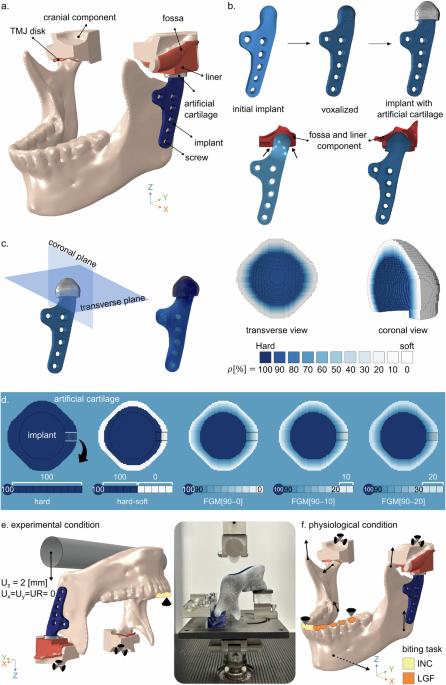功能分级软硬界面的多材料三维打印技术,用于增强颞下颌关节置换假体的下颌运动学性能
IF 9.6
Q1 MATERIALS SCIENCE, MULTIDISCIPLINARY
引用次数: 0
摘要
颞下颌关节(TMJ)置换假体在适应平移运动方面经常面临限制,导致不自然的运动学和加载条件,从而影响功能和寿命。在此,我们研究了颞下颌关节假体中的功能分级材料(FGMs)在增强下颌骨运动学和降低关节反作用力方面的潜力。我们为颞下颌关节植入物开发了一种功能分级人工软骨,并评估了五种 FGM 设计:硬质、软硬结合以及从 90% 硬质材料逐渐过渡到 0%、10% 和 20% 的三种 FGM 梯度。这些设计均采用三维打印技术,在准静态压缩条件下进行了机械测试,并在生理条件下进行了模拟。将计算建模和实验结果与切牙紧咬和左组咬合时的完整下颌骨进行比较。在切牙咬合和左组咬合过程中,硬质材料从 90% 过渡到 0% 的 FGM 设计将运动学性能提高了 19%,性能降低了 3%,关节反作用力分别降低了 8% 和 10%,下颌骨运动分别增加了 20% 和 88%。这些发现为下一代颞下颌关节植入物提供了宝贵的见解。颞下颌关节假体的平移运动存在局限性,影响了其功能性和使用寿命。在这里,一种附着于颞下颌关节植入物的三维打印功能分级人工软骨改善了下颌关节的运动学特性和运动范围。本文章由计算机程序翻译,如有差异,请以英文原文为准。

Multi-material 3D printing of functionally graded soft-hard interfaces for enhancing mandibular kinematics of temporomandibular joint replacement prostheses
Temporomandibular joint (TMJ) replacement prostheses often face limitations in accommodating translational movements, leading to unnatural kinematics and loading conditions, which affect functionality and longevity. Here, we investigate the potential of functionally graded materials (FGMs) in TMJ prostheses to enhance mandibular kinematics and reduce joint reaction forces. We develop a functionally graded artificial cartilage for the TMJ implant and evaluate five FGM designs: hard, hard-soft, and three FGM gradients with gradual transitions from 90% hard material to 0%, 10%, and 20%. These designs are 3D printed, mechanically tested under quasi-static compression, and simulated under physiological conditions. Results from computational modeling and experiments are compared to an intact mandible during incisal clenching and left group biting. The FGM design with a transition from 90% to 0% hard material improves kinematics by 19% and decreases perfomance by 3%, reduces joint reaction forces by 8% and 10%, and increases mandibular movement by 20% and 88% during incisal clenching and left group biting, respectively. These findings provide valuable insights for next-generation TMJ implants. Temporomandibular joint prostheses have limitations in their translational movements that affect functionality and longevity. Here, a 3D-printed functionally graded artificial cartilage attached to the temporomandibular joint implant improves the mandibular kinematics and movement range.
求助全文
通过发布文献求助,成功后即可免费获取论文全文。
去求助
来源期刊

Communications Materials
MATERIALS SCIENCE, MULTIDISCIPLINARY-
CiteScore
12.10
自引率
1.30%
发文量
85
审稿时长
17 weeks
期刊介绍:
Communications Materials, a selective open access journal within Nature Portfolio, is dedicated to publishing top-tier research, reviews, and commentary across all facets of materials science. The journal showcases significant advancements in specialized research areas, encompassing both fundamental and applied studies. Serving as an open access option for materials sciences, Communications Materials applies less stringent criteria for impact and significance compared to Nature-branded journals, including Nature Communications.
 求助内容:
求助内容: 应助结果提醒方式:
应助结果提醒方式:


